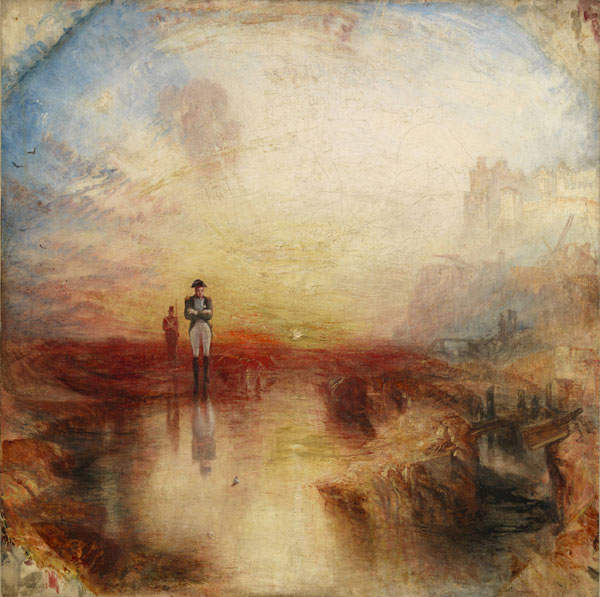

Turner painted enough brooding skies to make the term ‘twilight of his career’ a fiercely competitive list of his best works rather than an apt metaphor. Regardless, this period in the artist’s life is the subject of Tate Britain’s latest exhibition. It’s no small undertaking, balanced finely as it is between providing enough reinvention to justify the examination and being an exposition astute enough to spike interest beyond rose-tinted affection.
This exhibition certainly conjures appreciation, guaranteed with such a cherished talent, but doesn’t bring much new light to this beacon of British art. And why should it? If the mantra is the freeing of painting then we shouldn’t complain that the curation is light, if a little tepid. Indeed, perhaps its strength lies in not focusing on ideas and themes contemporary to Turner. But if this is the case one must ask the question: what is the painting being set free from?
On entering one is greeted by twilights of Classical reminiscence. The vibrancy of Rome, blurred, brings about a distinctly Victorian nostalgia for an imagined antiquity. The likes of ‘Agrippina Landing with the Ashes of Germanicus’ (top) mark well the obtuse Victorian conversation with the upright heroes of empire and legend and their perceived moral superiority.
Turner was too wise to care about that and these pieces are interesting and enthralling because they are creatively unfettered, not because they harbour ideals. Politics is painful and we lose much when we see these works through such a lens. I accept this, but cannot detach the orange faces of the Roman crowd, heaped like fallen fruit, from the huddled masses slummed in Turner’s industrial London.

If there are threads here they are silk. Perhaps the strongest is the increasing power of Turner’s light. it is tangible to the extent all other shapes are merely apparitions floating in a beautiful vortex. His renderings of Venice are predictable in their framing but no less diminished in their accomplishment.
‘The Dogano, San Giorgio, Citella, from the Steps of the Europa’ (1842) stands out with the staggering light in front of the buildings, which hover on the marble banks of the city, as if waiting to be invited into the delicate carnival of sunlight on water that Turner attends to so religiously. Again it’s tempting to draw parallels between the rise and fall of maritime empires, but maybe Venice just makes a better painting – Caravaggio made London look like Venice, not Venice look like London.
While there is a clear timeliness to Turner’s art, it is still the medium, not the message, that stands out. The fading provincial England shuddering beneath the viaduct of ‘Rain, Steam and Speed’ is subject to Turner’s brilliant brushwork ahead of his critique of the coming modern age, the steam and squall making a heady brew of light in action.
The loose chronology works, and adds to the sense Turner was rising, away from any other orientations that would corrupt the purity of his art. The sunset in ‘War. The Exile and The Rock Limpet’ (below) is the real subject that draws the viewer to appreciate the aesthetic beyond the obvious metaphor in a painting depicting a melancholy Napoleon on the shores of St Helena. Again it’s a painting that transcends its subject, which might look trite were the art not so original.

The penultimate room is made up of his sea paintings and ‘that real sea feeling’ (according to a sailor who visited Turner in his studio). The expression is almost psychological, from the uneasy creep of nature in his whaling ships trapped in ice to the half-formed visions emerging from ‘Sunrise with Sea Monsters’. This is made all the more haunting by the apparition of the thoroughly modern abstract in ‘Rough Sea’ (c1840-5), bold and brilliant in its uncoupling from walled meaning. There is power here, these are paintings you watch, mindful of Poseidon and Prospero.
The likes of Sturm und Drang and Romanticism are not explicitly referenced in this exhibition. Instead of abstract themes we are offered Turner’s tools – his spectacles and palette knives, his watercolour blueprints and his caricature by William Parrot. It works, giving a foundation to the unique talent via the comparative mundanity of the object.
There is no revolution, or escape to Xanadu here, just the freedom of paint and canvas; in establishing that, this exhibition more than delivers. In answering the question of what the work is being set free from it doesn’t do enough to draw on the contemporary lines of convention, but it doesn’t have to: as it shows, Turner has more than proved his right to be free.
Late Turner – Painting Set Free runs until 25 January 2015 at Tate Britain






